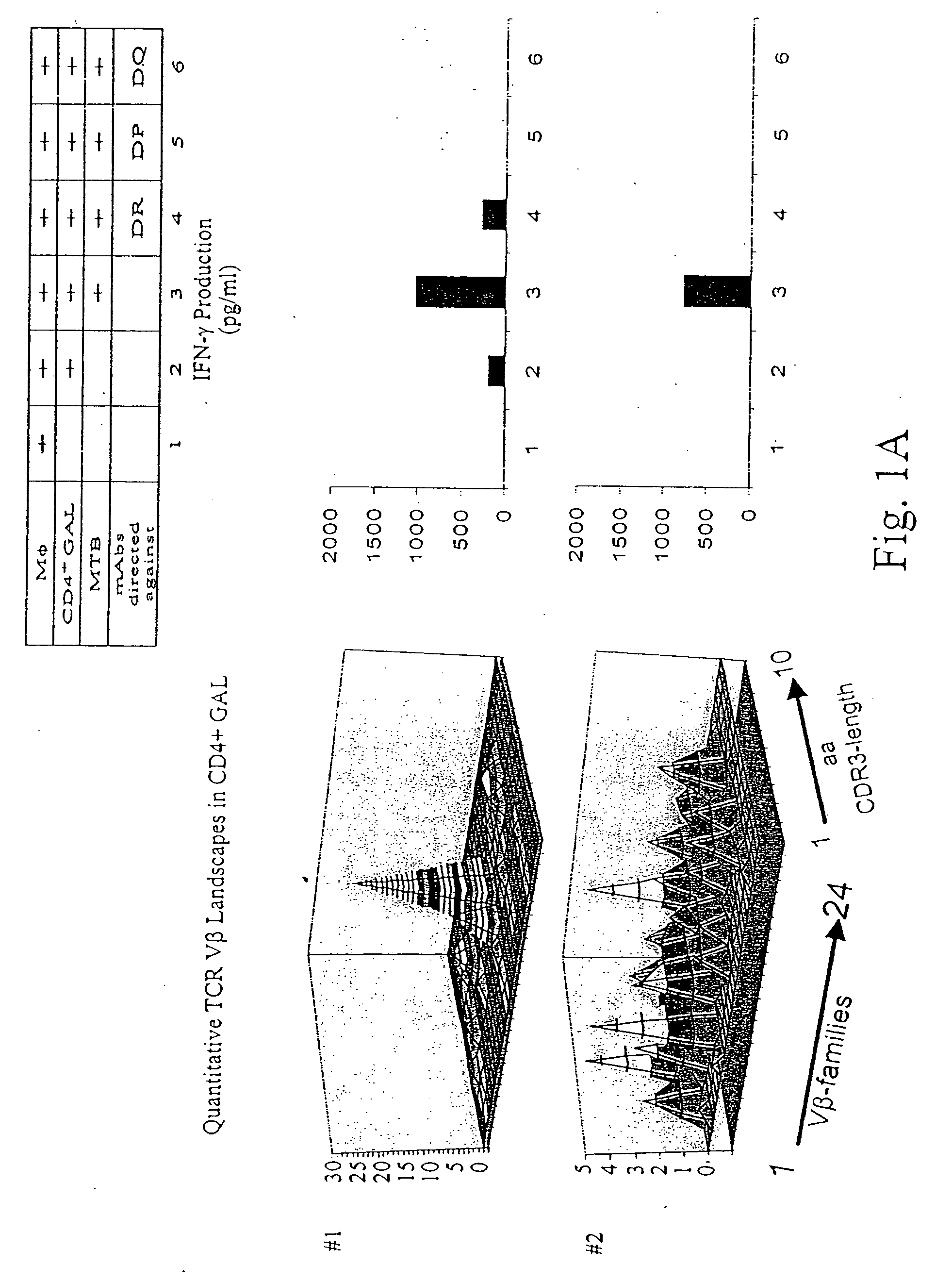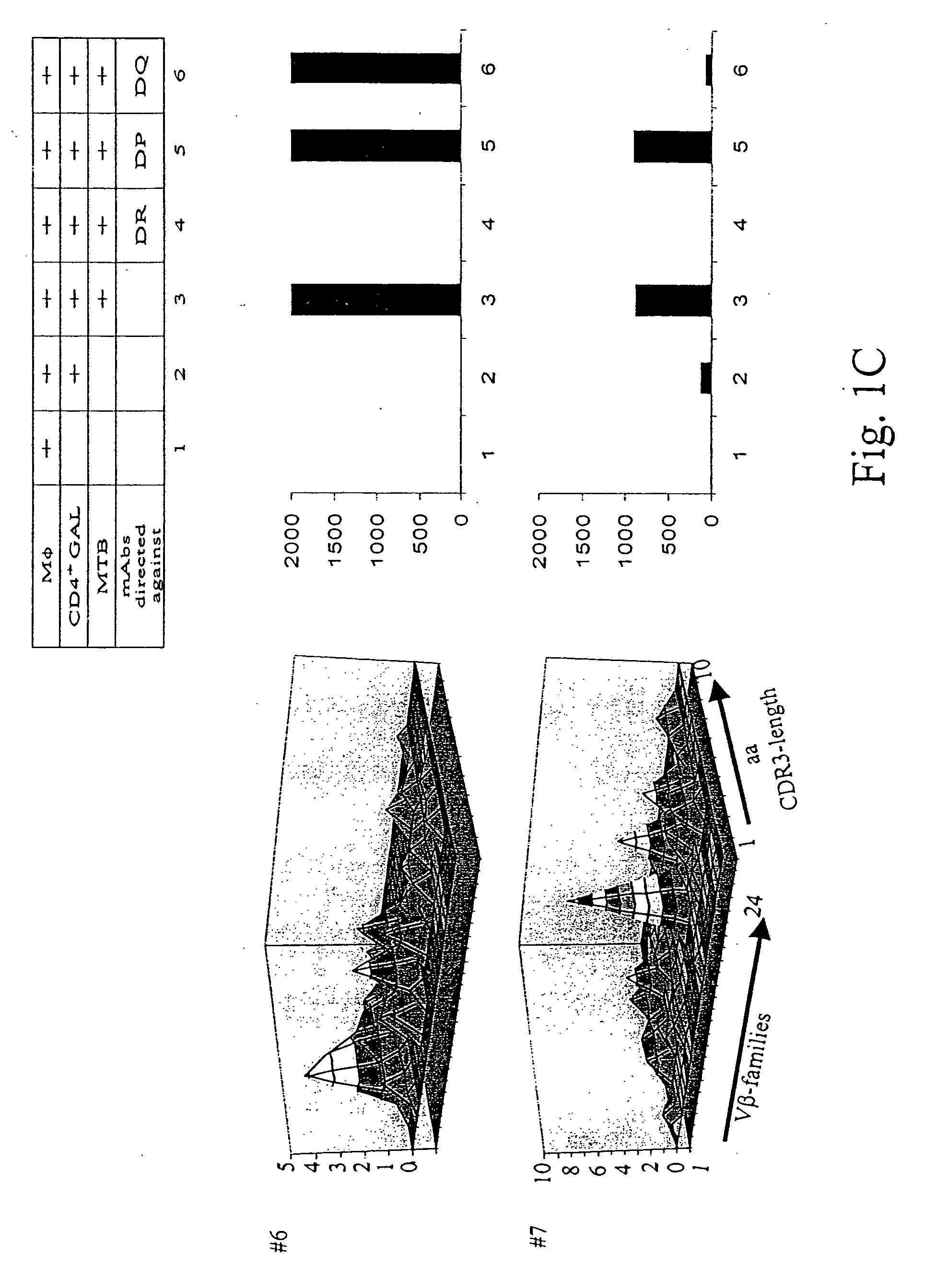Mycobacterium tuberculosis epitopes and methods of use thereof
a technology of mycobacterium tuberculosis and epitopes, applied in the field of immunology, can solve the problems of latent mtb infection, unavailability of protective vaccines, and inability to detect mtb strains,
- Summary
- Abstract
- Description
- Claims
- Application Information
AI Technical Summary
Problems solved by technology
Method used
Image
Examples
example 1
Materials and Methods
[0131] Patients diagnosed with pulmonary tuberculosis (five of seven) were recruited from the university hospital Heidelberg. Tuberculosis was diagnosed by typical lesions y X ray and PCR-based MTB-identification. Lung tissue has been obtained by surgery in order to rule out a malignant lesion. If granulomatous tissue has been identified by HE-staining, freshly isolated lung tissue has been placed in RPMI medium, supplemented with 10% FCS and antibiotics, and was processed as described earlier to obtain T-cells from colorectal cancer tissues. T-cells from lung granulomatous lung tissue were designated as granuloma associated lymphocytes (GALs). Two of seven patients were diagnosed with rheumatoid arthritis or sarcoidosis, respectively (listed in Table 2). All patients tested positive for PPD-reactivity. Blood was drawn after informed consent of the individuals enrolled in the study which has been approved by the local ethics committee.
[0132] He...
example 2
HLA-DR4-Restricted ESAT-6 or AG85b-Tetramer-Sorted CD4+ T-Cells Recognize Naturally Processed and Presented Mycobacterial Antigens and are Present in Pulmonary Granuloma Lesions
[0139] PBL from healthy HLA-DR4+ blood donors were tested for reactivity with HLA-DR4 tetramers loaded with peptides provided from the Ag85b, 19 kDAg and the M. tuberculosis specific antigen ESAT-6. Exclusively Tine-Test positive individuals tested positive for reactivity to any of the above listed antigens in the CD4+ T-cell population. In vitro expansion of CD4+ PBL in the presence of the nominal T-cell epitopes resulted in an expansion of CD4+ tetramer-reactive T-cells in Tine-Test positive and negative individuals. Both prior to and after in vitro stimulation, these T-cells were members of in the precursor CD4+CD45RA+CD28+ T-cell subset. Ex vivo analysis of tetramer-sorted CD4+ T-cells using either the Ag85b or the ESAT-6 epitope clearly showed that CD4+, HLA-DR4-restricted, and Ag85b-reactive T-cells re...
example 3
HLA-DR4-Restricted and Mycobacterium-Specific T-Cells Reside in the CD45RA+CD28+ and CD45RA−CD28− T-Cell Population and Show Different Dynamics Associated with Antigen-Specificity
[0141] For longitudinal analysis, PBL were harvested from five patients with pulmonary tuberculosis at the time of diagnosis and after 2 and 16 weeks after diagnosis / initiation of therapy and tested for the reactivity to the 19 kDA antigen, the Ag85b and ESAT-6 in HLA-DR4 restricted CD4+ T-cells (FIG. 11A). The corresponding CD8+ and HLA-A2 restricted T-cell responses have been evaluated in three patients. Three of five patients showed an increase of DR4-restricted T-cells over time for ESAT-6 reactivity (patients MZTB1, -3 and -4). Patients MZTBC-3 and -4 showed also a corresponding increase for the HLA-A2 restricted epitope for ESAT-6, the CD8+ T-cell response in patient MZTBC-1 has not been tested. Four of 5 patients (except patient MZTBC-4) showed a decrease of DR4 restricted T-cells for the Ag85b epi...
PUM
| Property | Measurement | Unit |
|---|---|---|
| thickness | aaaaa | aaaaa |
| half life | aaaaa | aaaaa |
| concentrations | aaaaa | aaaaa |
Abstract
Description
Claims
Application Information
 Login to View More
Login to View More - R&D
- Intellectual Property
- Life Sciences
- Materials
- Tech Scout
- Unparalleled Data Quality
- Higher Quality Content
- 60% Fewer Hallucinations
Browse by: Latest US Patents, China's latest patents, Technical Efficacy Thesaurus, Application Domain, Technology Topic, Popular Technical Reports.
© 2025 PatSnap. All rights reserved.Legal|Privacy policy|Modern Slavery Act Transparency Statement|Sitemap|About US| Contact US: help@patsnap.com



